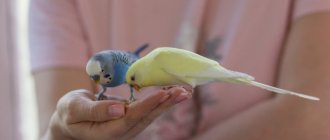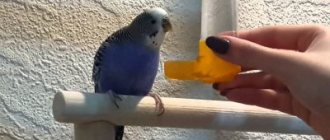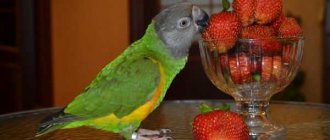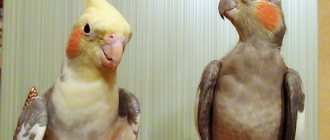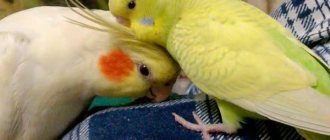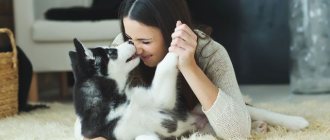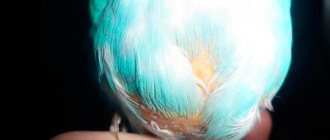“You will always be responsible for the one you have tamed”: folk wisdom, first heard from the lips of Antoine de Saint-Exupéry in the story “The Little Prince”, carries a huge meaning that is still popular in our time. Owning a pet is a responsible choice that must be made with all due care. Cute parrots are frequent guests of apartments and houses and require special care.
The procedures for purchasing a pet and cage are only the first step towards constant and proper communication with the future member of your family. Like any other poultry or animal, cockatiels run the risk of getting sick, although this happens quite rarely. The pet owner should consider in advance the question of exactly what diseases, infections and pathologies may appear in his pet, and how they can be dealt with.
Symptoms
Like people, each parrot disease has its own list of characteristic symptoms. It is almost impossible to determine at a glance what kind of disease or infection a pet is suffering from, but there are manifestations that help you understand that your bird’s health is not in order:
- lethargy, weakness, indifference and lack of reactions;
- loss of appetite;
- damaged, weak and easily broken feathers;
- too heavy and rapid breathing;
- sneezing and discharge from the nostrils;
- redness of the eyelids;
- closing the eyes;
- lameness and falling from a perch;
- dulling of the beak and the formation of spots or abscesses on it.
The presence of this kind of sore in a bird is determined visually by examining the corresponding part of the body. This list of symptoms does not answer the question of what exactly your parrot is sick with.
The manifestation of one or more conditions only signals the presence of health problems, and a specific pathology can only be determined with the help of a veterinarian or independent research.
For example, diarrhea is a common symptom of illness and pathology in cockatiels, caused by a whole range of various ailments, including: the presence of infections, poor-quality food, problems with the functioning of the kidneys or liver, etc. The quality of the necessary treatment depends on the presence of the necessary hygiene in the cage. Strong help is the correct diet, designed based on the advice of an ornithologist.
Diagnostic methods
The treatment is carried out by a dentist-therapist. Diagnosis begins with an examination and a detailed survey: the doctor will find out what medications you have taken recently, and whether there are any chronic or infectious diseases. A cytological examination of plaque taken from the mucosa is mandatory. This is important because a buildup of non-fungal flora can easily be confused with a fungal infection.
The scraping is performed in the morning, on an empty stomach; there is no need to brush your teeth before the procedure. The day before, it is important to avoid eating foods rich in carbohydrates so as not to provoke the growth of pathogenic flora. Research allows not only to accurately determine the causative agent and type of Candida fungus, but also to find out the sensitivity of fungi to the main antifungal drugs. Based on the test results, the doctor will determine the fungus in the oral cavity and prescribe medication.
Diseases of the gastrointestinal tract
Diseases and infections of the gastrointestinal tract are a common problem that affects parrots and their loving owners. The cause of pathologies in this area of the body can be a dirty drinking bowl, non-compliance with hygiene standards, etc.
If problems of this nature arise, you should immediately contact a specialist ornithologist: a certified avian doctor will skillfully make a diagnosis and immediately begin the necessary treatment.
Left unattended and untreated, such an incorrect disease can lead to the death of your parrot!
Gastroenteritis
Gastroenteritis (inflammation of the stomach or intestines) is probably the most common cause of death in pet parrots. The appearance of such diseases in Corella parrots is usually associated with low-quality food: contaminated grain or rotten fruit. The presence of this kind of sore in a bird is determined visually by examining the corresponding part of the body. The cause of severe inflammation often lies in a poor-quality, incorrect diet. The main symptoms of gastroenteritis include:
- diarrhea;
- green discharge;
- blood when excreted;
- regurgitation;
- excessive thirst;
- complete loss of appetite.
Despite the severity of the situation, bird owners can be reassured - even a disease such as gastroenteritis can be treated quite simply. The necessary therapy, carried out in a timely manner by a specialist called by an ornithologist, includes the use of all kinds of enterosorbents and antibiotics. In addition to such treatment, the birds are given regular injections of all kinds of vitamin compounds.
The quality of treatment depends on the presence of the necessary hygiene in the cage.
Diarrhea or constipation
Constipation and diarrhea are two classic manifestations of problems with the quality of your poultry's nutrition. Parrots who are sedentary and prone to obesity often experience problems associated with poor-quality stool. Also, the occurrence of such symptoms can be caused by a lack of succulent food and the predominance of dry grain in the daily diet of a pet.
Difficulty defecating is often observed in birds suffering from all kinds of intestinal infections. The cause of severe inflammation often lies in a poor-quality, incorrect diet. The assistance provided in this case boils down to improving the passage capacity of the cloaca. The presence of this kind of sore in a bird is determined visually by examining the corresponding part of the body.
Strong help is the correct diet, designed based on the advice of an ornithologist.
When constipated, parrots begin to give direct verbal messages signaling the presence of a problem: the bird crouches, shakes its tail and expresses the urge to defecate.
The owner observing such a picture can help his feathered friend by introducing vegetable oil into the cloaca and 3 drops of castor oil into the beak. Naturally, such measures will only help with constipation. Diarrhea is a more long-term problem, which should be addressed to a specialist or ornithologist.
The body of birds is particularly resistant to all kinds of diseases, but this property manifests itself only with regular prevention.
Food poisoning and infections
Food poisoning in cockatiels can be caused not only by poor quality food, but also by tobacco smoke and even the smell of burnt food. Also, the occurrence of such problems is associated with the presence of alcohol, laundry soap, indoor plants, paint and lead in the immediate vicinity of the cage.
If the reason your parrot is feeling unwell is due to smoke or toxic fumes, the first thing to do is take your bird out into the fresh air. Intoxication, which is a consequence of taking substances harmful to the health of poultry, is treated with the help of drugs:
- Activated carbon;
- smecta;
- sorbex;
- carbolene;
- atoxyl, etc.
The tablets are ground into fine flour and given to cockatiels along with a small amount of water, using a pipette or syringe. The cause of severe inflammation often lies in a poor-quality, incorrect diet. Help from such medicine will appear after 2-3 days of active drinking.
Candidiasis
Candidiasis is a classic “parrot” infection, a disease caused by the yeast fungus Candida albicans. Such problems most often arise in young representatives of the cockatiel species, as well as in parrots with weakened immune systems. Candidiasis can be caused by severe stress, vitamin deficiency, nutritional problems, unsanitary living conditions, etc. It is almost impossible to cope with such a disease on your own - you will have to contact an ornithologist.
Therapy for such an abnormal disease includes taking medicinal antifungal drugs, as well as general recommendations for improving the quality of keeping your pet. During the treatment period, the bird will need special, more attentive care. Left unattended pathology can lead to the death of your parrot, and the quality of treatment depends on the presence of the necessary hygiene in the cage.
Fresh air, quality food and systematic communication are the best preventive conditions. The body of birds is particularly resistant to various diseases, but this property manifests itself only with regular prevention. Strong help is the correct diet, designed based on the advice of an ornithologist.
Dysbacteriosis
Dysbiosis (loss of functionality of the intestines and intestinal organs) is an unpleasant, but far from fatal pathology that a parrot suffering from existing intestinal infections may encounter. Most often, dysbiosis is a concomitant symptom that is part of the abnormal diseases present in your bird.
The presence of the disease can be determined by a change in the animal’s behavior: its mood deteriorates, and frequent, copious and liquid bowel movements begin. Such a disease (food or intestinal infection) can lead to serious health problems for your pet parrot. The presence of this kind of sore in a bird is determined visually by examining the corresponding part of the body.
The procedure for eliminating dysbiosis includes two aspects - taking medications and improving general maintenance standards. Enzyme preparations and sorbents should be used in treatment. You definitely need to adjust the diet of your favorite cockatiel: remove juicy fruits, vegetables and grass.
The cause of severe inflammation often lies in a poor quality, incorrect diet.
Types of pathology
Doctors distinguish several types of annular erythema, depending on the causes of the disease:
- centrifugal erythema Daria - most often affecting middle-aged men, less often - children and the elderly, related to infectious-allergic manifestations;
- migratory - a disease of an infectious nature that occurs as a result of a tick bite infected with Borrelia;
- rheumatic, or ring-shaped anular erythema is one of the symptoms accompanying rheumatism, characteristic of children and adolescents.
According to external signs, ring erythema can occur:
- in flaky form - with peeling of dead skin along the edges or the entire surface of the spots;
- in vesicular form - with the appearance of small liquid-filled bubbles along the edge or entire surface of the spots;
- in a garland-shaped form - with the easiest flow, which is characterized by pale pink spots, arranged in chains or garlands and disappearing after a few days;
- in a microgarland-shaped form - with small spots, up to 1 cm in diameter, sometimes accompanied by peeling or the formation of bubbles, with a long course.
The medical literature also mentions other, very rare types of annular erythema - telangiectatic, purpuric or indurated.
Feather loss
The loss of feathers and down is a normal process that occurs in the life of every parrot with increasing and decreasing activity. The cage with a pet is almost always slightly littered with small feathers - they fly out of the bird’s body with simple shaking. The rate of feather loss due to disease increases during the molting period - after this time, the cockatiel receives a new, fresh, clean and elastic downy coat.
You need to sound the alarm if your pet parrot independently pulls out healthy, strong feathers from its body. At such moments, the bird may begin to itch, scratching its body literally until it bleeds. Another possible problem is the disease of lack of feather renewal processes.
If your parrot's old plumage has fallen out, but new plumage does not appear, immediately contact an ornithologist. Remember that the quality of treatment depends on the presence of the necessary hygiene in the cage. Fresh air, quality food and systematic communication are the best preventive conditions.
The body of birds is particularly resistant to various diseases, but this property manifests itself only in the presence of regular prevention.
Incorrect molt
Molting is a common process that occurs in the life of every parrot, usually 1-2 times a year. At this time, the bird’s body gets rid of old fluff, trying to cleanse the carcass of previous feathers.
On average, such molting lasts 1.5-2 months - during this time your pet parrot has time to completely renew its downy coat. At such moments, the adopted child needs special care; his body spends a huge amount of vitality to complete natural processes. In order for the bird to survive the molt without any consequences, try to follow these tips:
- Provide your friend with regular baths, or wash him yourself with a spray bottle.
- Ventilate and moisten the room in which the cage is located.
- Add cottage cheese, boiled eggs, herbs and sprouted grains to your diet. You can use special, specialized food intended for consumption during molting.
- In warm, sunny weather, expose the cage to fresh air, covering only one side of the pet’s home with a dark cloth.
By following these tips, you can help your cockatiel avoid all the dangers associated with improper shedding.
Self-plucking
Self-plucking is, oddly enough, a psychological or psychosomatic abnormal disease that occurs in parrots after severe stress or from lack of communication. The condition of a pet that has experienced trauma, strong mechanical shocks, or attacks from other animals or birds can cause the cockatiel to begin to pull out healthy, high-quality feathers. In order to prevent the onset of illness, pathology, infection and disease processes, you should provide your pet with good living conditions. A cockatiel suffering from self-plucking will improve when various interesting things appear in her life. The cause of severe inflammation often lies in a poor quality, incorrect diet.
Features of treatment
The basis of treatment is systemic and local antifungal drugs. Today they are widely represented on the pharmaceutical market, but it is important to know that every year the level of resistance of Candida fungi to basic drugs increases. For example, resistance to drugs such as Fluconazole is almost complete. Previously, this remedy was used in almost all cases of the disease, but today doctors are forced to reconsider standard treatment regimens.
Treatment of oral thrush in adults is selected individually. The choice of systemic antifungal agent is based on the type of pathogen, the patient’s condition and the individual characteristics of his health. There are drugs to which the infection has minimal resistance. The doctor may prescribe drugs based on nystatin, imidazole derivatives, etc.
Additionally, local remedies must be used:
- solutions for rinsing the mouth;
- gels and suspensions for application to affected areas;
- local tablets and lozenges;
- Irrigation solutions and aerosols;
- ointments for placing in the oral cavity on a cotton-gauze swab, etc.
A specialist may prescribe pharmaceutical antiseptics or weak saline solutions for rinsing. Typically, solutions based on iodine, chlorhexidine, potassium permanganate, gentian violet, sodium tetraborate in glycerin are used. Your doctor may recommend placing some tablets in your cheek.
Beak diseases
The beak is an integral part of the body of every parrot, representing a dense and hard growth of horny tissue formed on a bony protrusion. You can check whether the beak is healthy with a simple visual inspection. The presence of this kind of sores and diseases in a bird is determined visually by examining the corresponding part of the body. In parrots that do not experience any medical or mental problems, this part of the body has the following qualities:
- smoothness, strength and healthy shine;
- no cracks or deformations;
- no broken edges;
- no deformation in the area of the elongated part;
- smooth and matte wax;
- the beak fits tightly to the bony protrusion;
- clean, uninflamed nostrils.
The occurrence of such pathologies associated with the beak will lead to a real eating disorder. The adopted child simply will not be able to eat well, because the main device for eating will be in an ineffective and painful state.
The cause of severe inflammation often lies in a poor quality, incorrect diet.
Inflammation
Beak inflammation is a serious disease and food or intestinal infection that, unfortunately, often occurs in young cockatiels. The main reasons for the appearance of various pathologies in this part of the pet’s body include:
- burns;
- mechanical injuries;
- cracks;
- infection with infectious or fungal bacteria;
- emergence of viruses.
Only an experienced master and ornithologist with relevant knowledge in medical ornithology can cope with the necessary and necessary treatment of all kinds of inflammation of the beak. In this case, the quality of treatment will depend on the presence of the necessary hygiene in the pet’s cage.
Fresh air, quality food and systematic communication are the best preventive conditions.
Overgrowth
The beak is a constantly growing part of the cockatiel's body. Increased processes of growth occur throughout the life of a pet, which, as the beak grows, manages to grind off the resulting “excess.” However, the appearance of all kinds of malfunctions in the cockatiel’s body can lead to disruptions in the natural process - the beak will grow, become thin, soft, fragile or layered. The presence of this kind of sore in a bird is determined visually by examining the corresponding part of the body.
The main reason for excessive growth is improper diet. All kinds of food are often saturated with a huge number of additives, which have the most unpredictable effect on your bird’s body. The necessary treatment for such a disease is a fairly radical measure. You will have to shorten the beak yourself, trimming its edges with extreme care.
After all the necessary procedures, the damaged cornea is lubricated with a solution of vitamin A. The healing diet required for implementation at the time of such an operation is soft food, which should contain calcium gluconate.
Left unattended pathology can lead to the death of your pet parrot.
Conditions for effective treatment
Effective treatment for oral thrush involves eliminating the underlying cause. It is very important to sanitize the oral cavity: cure teeth destroyed by caries, remove non-viable teeth and roots that can no longer be restored. These are chronic foci of inflammation, so simultaneous sanitation will shorten the treatment time. Tartar and plaque should also be removed. This is especially true for cases of candidal stomatitis associated with injury to the gums by the sharp edges of hard dental deposits.
Patients with removable dentures should be re-trained in hygiene and disinfection of orthopedic structures. If the time to use a prosthesis comes to an end, it is important to replace it in a timely manner. Treatment of candidiasis will be useless if a person uses the denture incorrectly and again creates conditions in the oral cavity for the growth of fungi.
Unsuitable crowns, bridges and other structures must also be replaced. It is also important to eliminate chipped enamel, which becomes a source of injury to the gums, mucous membranes of the cheeks and tongue.
Smokers should reduce their smoking episodes if possible or quit the bad habit. If the disease has developed while taking corticosteroids, it is important to explain the rules of treatment: you should rinse the mouth with plenty of warm water after spraying the drug.
When treating oral candidiasis that has developed during antibacterial therapy, measures should be taken to restore the normal microflora of the intestine and oral cavity. You may need to consult another specialist or therapist: you will need to take probiotics and prebiotics.
For all patients treated for candidiasis, several general recommendations apply:
- maintaining oral hygiene;
- refusal of foods rich in carbohydrates;
- giving up sugary drinks.
It is necessary to exclude from the diet foods that can irritate the mucous membranes: dishes prepared with vinegar, marinades, spicy, peppery foods, smoked foods, sour fruits and berries. You should also not eat confectionery, baked goods made with yeast, or sugar. It is better to give preference to warm dishes. You need to follow this diet for another 1.5-2 months after recovery.
In some cases, it is advisable to use toothpastes with glucose oxidase, lysozyme, and lactoferrin. They help improve the defenses of the oral mucosa and can be part of a comprehensive prevention of inflammation. The choice of toothpaste should be agreed with your doctor; he will recommend the optimal product, and also tell you which brush is suitable.
Colds
Corella, like almost any other parrot, is an extremely gentle, heat-loving creature that makes special demands on its life support. Despite the fact that your parrot can cope with sudden changes in temperature without any problems, the consequences of such situations will affect his health in the most negative way. One of the most terrible and incorrect diseases is all kinds of respiratory complications caused by frequent drafts and regular temperature collapses in the cage.
Inflammation of the lungs and pulmonary vesicles can lead to the death of a pet, which will happen especially soon if proper measures are not taken. Such pathologies can only be treated with the necessary help from ornithologist specialists, who include in the therapy all kinds of antibiotic and enterogenous agents, as well as sorbents.
Remember that the quality of treatment also depends on the presence of the necessary hygiene in your pet’s cage!
Chronic pharyngitis
According to the depth of damage to the pharyngeal mucosa, chronic pharyngitis is divided into: catarrhal, hypertrophic and atrophic forms.
- Chronic catarrhal pharyngitis - there is slight swelling of the tissue layers of the pharyngeal mucosa. Individual areas are sometimes covered with clear or slightly cloudy mucus. It develops as a result of acidic gastric contents entering the throat, for example, in the case of a hiatal hernia. Therefore, catarrhal chronic pharyngitis is a consequence of the development of diseases of the gastrointestinal tract.
- Chronic hypertrophic pharyngitis is a significant severity of swelling of the mucous membrane. Additionally, thickening of the uvula and swelling of the soft palate are observed.
- Chronic atrophic pharyngitis is characterized by some thinning of the lining of the pharynx. They are usually pale pink, sometimes shiny varnished. Some of their areas become covered with crusts, viscous mucus and pus.
Any type of chronic pharyngitis develops due to the fact that the acute form of the disease was not cured in time and developed into a more serious form. Chronic pharyngitis also appears as a consequence of rhinitis, sinusitis, deviated nasal septum, nasal polyps - that is, when nasal breathing is difficult for a long time. In addition, long-term use of vasoconstrictor drops also leads to the appearance of chronic pharyngitis.
Eye diseases
You can detect that your pet parrot is suffering from diseases related to the eyes by changes in the pet’s behavior: the bird begins to blink frequently and close its eyes. Such situations are often caused by the appearance of foreign objects in the immediate vicinity of the pet’s eyes. The presence of this kind of sore in a bird is determined visually by examining the corresponding part of the body. Sand, small specks and husks that prevent the parrot from looking at the world around him normally should be removed with a clean cotton pad.
Checking your parrot for eye pathologies is very simple. The foster child, who is in normal condition, has clean, slightly shiny beady eyes. In moments of health problems, they become cloudy, pus begins to flow, and the area around the visual organs acquires an unhealthy reddish color. It is necessary to treat such manifestations using a solution of sodium sulfate or furatsilin. The necessary washing and instillation procedures are carried out 2-3 times a day, and at night the bird needs to put a drop of tetracycline ointment under the eyes.
Remember that the quality of treatment also depends on the presence of the necessary hygiene in the pet’s cage. Fresh air, quality food and systematic communication are the best preventive conditions.
Bibliography
- Gynecology textbook. IV edition ed. Academician of the Russian Academy of Medical Sciences, Professor G.M. Savelyeva; prof. V.G. Breusenko 2012
- Urogenital candidiasis. Clinical recommendations. Moscow, 2016 – 22 p.
- Vulvovaginal candidiasis: pathogenesis, diagnosis and treatment tactics. Bayramova G.R., Amirkhanyan A.S., Chernova V.F. //Doctor.Ru 2018. No. 10 (154). pp. 32-36
- Sherry L., Kean R., McKloud E., O'Donnell LE, Metcalfe R., Jones BL et al. Biofilms formed by isolates from recurrent vulvovaginal candidiasis patients are heterogeneous and insensitive to fluconazole. Antimicrob. Agents. Chemother. 2017; 61(9): e01065-17
- Prilepskaya V.N. Vulvovaginal candidiasis. Clinic, diagnosis, principles of therapy: manual / V.N. Prilepskaya, G.R. Bayramova - M 2008 - 50s
- Atlas of pathogens of fungal infections/E.N. Moskvitina and others - Moscow GEOTAR-Media, 2021 208p
- Zordan R., Cormack B. Adgesis on opportunistic fungal pathogens In: Calderone RA, Clancy CJ, ed Candada and candidiasis/ Washington: ASM press; 2012: 243-259)
- Zhang Y., Li W., Chu M., Chen H., Yu H., Fang C. et al. The AAA AT Pase Vps4 plays important roles in Candida albicans hyphal formation and is inhibited by DBeQ. Mycopathology 2016; (5-6) 329-39
- Murciano C., Moyes DL, Runglall M., Yobouti P., Islam A., Hoyer LL et al. Evaluation of the role of Candida albicans agglutinin-like sequence (Als) proteins in human oral epithelial cell interactions. Plos one 2012.
- Center for Disease Control (CDC) Sexually Transmitted Disease Treatment Guidelines, 2015.
- Donders GG, Bellen G., Mendling W. Management of recurrent vulvovaginal candidosis as a chronic illness. Gynecol. Obstet. Invest 2010 70(4):306-21
- Ankirskaya A.S. Muravyova V.V. Microbiological characteristics of vaginal infections caused by fungi of the genus Candida // sexually transmitted diseases 2001. pp. 12-14
- Eschenbach DA Chronic vulvovaginal candidosis N Engl. J Med 2004; 351(9)
- Tikhomirov A.L. Oleinik Ch.G. Optimization of treatment of recurrent vulvovaginal candidiasis // effective therapy in obstetrics and gynecology. 2007 No. 3 from 22-27
- Bayramova G.R. Recurrent vaginal candidiasis. Clinic, diagnosis, treatment. dis. Doctor of Medical Sciences M. 2013 (46s)
- Prilepskaya V.N. Bayramova G.R. Vulvovaginal candidiasis, modern ways to solve the problem. Difficult patient 2006 (from 33-36)
Skin diseases and infections
Diseases, infections and pathologies of the skin - dermatitis and other types of various pathologies, have bright, strongly expressed visual symptoms. Such abnormal diseases can arise due to a number of different reasons, including: inflammation, contact with irritating factors, injuries followed by infections, etc.
The main areas affected by symptoms are the shoulders, armpits, upper wings and root of the tail.
Such pathologies must be treated with the help of similar homeopathic remedies; in particular, good results can be achieved after taking apterin and inflammation. Inflamed areas on the bird's body should be treated with a 3% mummy solution, and also kept in a warm infusion of calendula or chamomile. When carrying out such events, remember that every bird needs the most proper and careful care.
Parasitic lesions: scabies mite, fluff eater, fleas
A cockatiel infected with parasites becomes restless, often itches, tearing the skin until wounds form, pulls out feathers, and screams. If the cause is identified, the doctor prescribes treatment in combination with continuous treatment of the bird’s habitat. Parasites are transmitted from sick birds to healthy ones, so a sick parrot must be isolated from healthy individuals, treating all birds without exception. It is advisable to keep the newly purchased bird in a quarantine cage for at least a month to exclude the possibility of infection with parasites.
Causes of otomycosis
Among the causes of infection are:
- various ear injuries;
- improper hygiene of the ears, or completely absent hygienic care of the ears;
- dermatological diseases - eczema, psoriasis, dermatitis, accompanied by itching of the auricle;
- anatomical abnormalities of the hearing organ - narrowness of the auditory canal, hyperplasia of the temporal bone tissue, etc.;
- complications of inflammatory diseases of the nasopharynx;
- imbalance of the microflora of the hearing organ;
- severe allergic reaction;
- diabetes;
- long-term treatment with antibiotics or hormones, leading to weakened immunity;
- constant stress;
- using someone else's headphones, earplugs, headsets, etc.
According to localization, inflammation can occur in the outer or inner parts of the ear, eardrum, or it can become a complication of the operation and affect the operated area.
